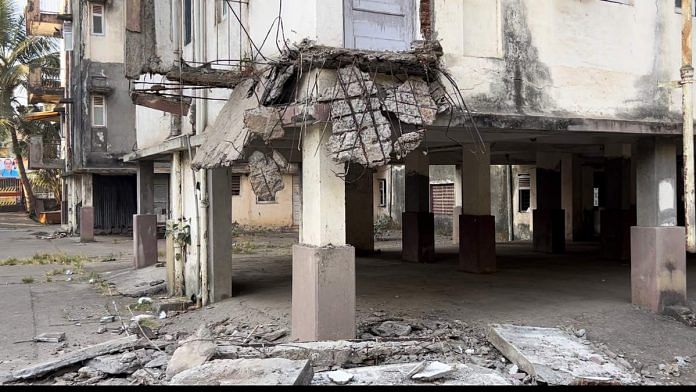Mumbai: Every night since 24 January, as Bhakti Wagal settles onto her pillow in her small apartment in Mumbai’s Air India Colony, a stifling anxiety overcomes her. When her eyes shut, she says, her mind conjures up flashbacks of a bulldozer inching menacingly closer to a house not very different from hers, the wrecking ball poised to deliver a devastating blow.
Two years after the sale of Air India to the Tata Group, several residents of the Air India Colony in Kalina have been fighting fiercely to retain their homes until retirement. These employees have batted off multiple eviction notices and knocked on the doors of first the Bombay High Court and later the Supreme Court. Arguing that accommodation is an “essential service condition” and a “promise” laid out in Air India’s Housing Allotment Rules, they want the issue treated and resolved as an industrial dispute.
Air India and the Union government, however, have rejected their pleas, contending that housing is not an essential service condition, but just a welfare measure, according to the same Housing Allotment Rules.
Wagal, a stay-at-home mother, and her husband, an engineer with Air India, have called the staff colony home for about 15 years. They are among the handful of families refusing to budge despite eviction notices being served on them following the disinvestment of the formerly state-owned air carrier.
Many from our colony have gone to strife-stricken nations to bring back flights of stranded Indians. We have done so much. Why should they deny us what they had promised?
-Sunita Rane, Air India Colony resident
The land parcel on which the Air India colony stands was not included in the airline’s sale to the Tata Group. Instead, it was transferred to a new company established to monetise Air India’s assets. This land, originally leased by the state government to the Airports Authority of India (AAI), had been allocated to Air India. Now, the Adani Airports-controlled Mumbai International Airport Limited (MIAL) is claiming it for expanding the adjacent airport.
On 24 January, MIAL representatives, escorted by police, entered the premises of one of the four Air India staff colonies. Their intent: to demolish 20 vacant, dilapidated buildings in order to clear land for the airport expansion. The residents, however, raised a hue and cry and the demolition exercise was aborted with a broken balcony as the only casualty.
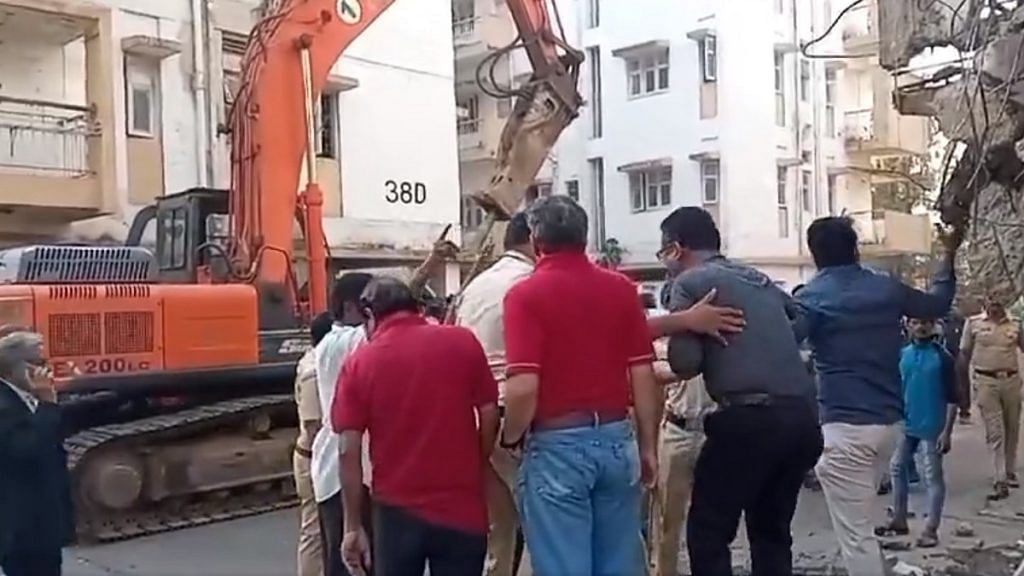
But that was enough to shake Wagal to the very core. The memory and the future it forebodes have haunted her ever since.
“I can’t eat or sleep peacefully, I can’t think about anything else,” Wagal said. “My entire being is possessed with thoughts of the bulldozer and the uncertainty over my house.”
Most of the roughly 3,000 apartments in the 105 buildings of the four Air India colonies in Mumbai’s Kalina are evidently empty.
Also Read: The last wedding, a post office & Ramlila at Air India Colony—memories of Maharaja’s staff
A dying colony
The road outside the four colonies of the Air India staff quarters, a stone’s throw from Mumbai airport, hums with activity. Construction equipment rumbles, cars honk, public buses screech to a halt, and pedestrians navigate the urban melee.
But inside the colonies, there are few signs of life. An unsettling silence shrouds lines of buildings where the paint has long peeled, the plaster has blackened, and windows have rusted. It could pass for a ghost town if not for a few balconies with clothes drying on them or the occasional auto rickshaw halting in front of one of the buildings. Most of the roughly 3,000 apartments in the 105 buildings are evidently empty.
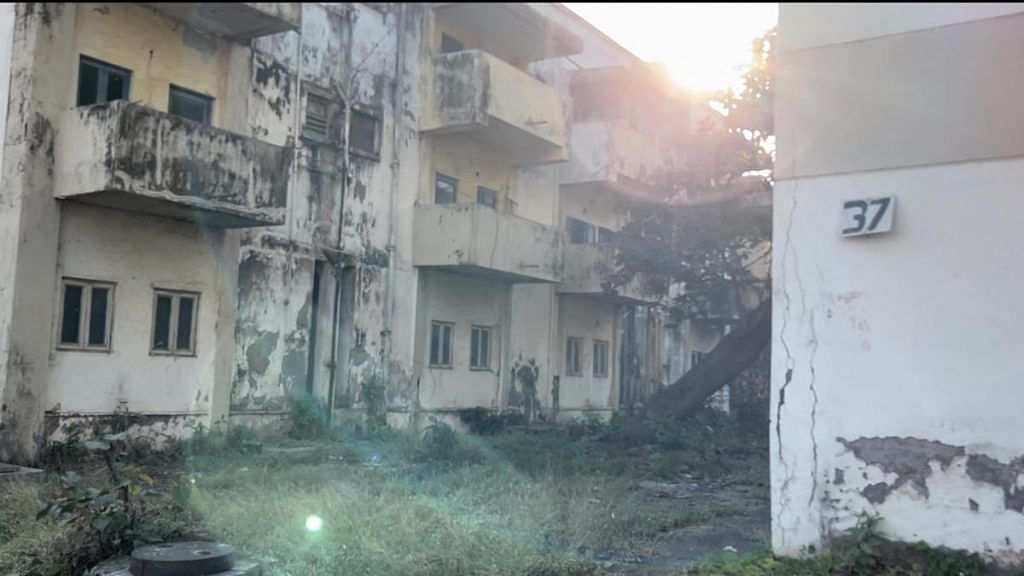
Despite this desolation, a band of residents resolutely prepared to celebrate Republic Day last month.
“It is now just a symbolic celebration, to continue a tradition that we have been following for years,” said Anjali Desai, who has been living in the colony for almost three decades. “Earlier, every celebration would be massive. People from outside the colony, from around the neighbourhood, would also join us.”
Desai wistfully narrates tales of the colony’s former beauty and vitality. Everyone who moved in decked up their balconies with flowering plants of all colours, cascading creepers, and soft lights. And everyone came together to pool in money and celebrate festivals of every religion.
“The youngsters had a WhatsApp group called ‘Psycho Boys’, and they did all the running around for any major celebration in the society. They are still in touch and some of them turn up at times even though they don’t live here,” Desai said. “When there were many houses, every family would contribute Rs 100-200 to celebrate festivals. Now, with just a few of us left, every household has to pitch in about Rs 2,000. But we still try to have these celebrations.”
Of the 350 families still here, at least 150 are such that they are really poor. They are the sweepers, loaders. They were counting on housing until their retirement.
-MP Desai, secretary of the Aviation Industry Employees Guild
As the dispute drags on, the society’s maintenance has taken a hit. Residents say that the Air India Assets Holding Company Limited (AIAHL), formed by the Union government post disinvestment, is now responsible for the four staff colonies but has stopped spending on upkeep, only covering security costs. Those still residing here are scrambling to manage other aspects of maintenance on their own.
Anjali’s husband, MP Desai, who handles passenger traffic at the airport, is playing a leading role in the residents’ fight to retain their homes until retirement. He serves as both the secretary of the Aviation Industry Employees Guild and the president of one of the four Air India colonies where they reside.
He said that the family has witnessed the colony crumble right before their eyes—from an estimated 2,300 families in 1999 to 1,200 in 2021 to just about 350 now.
The Union government has submitted to the Bombay High Court that only 410 employees remain in the colony, according to a March 2023 order. Of these, 238 have given undertakings to vacate the premises and will receive a house rent allowance upon their departure.
The Union government set up the Air India Assets Holding Limited (AIAHL) in 2019 for the transfer and monetisation of all the national carrier’s assets once it ceased to be a public company. These included “non-core assets” like the Air India colonies.
Disinvestment and fallout
Two schools and a cooperative credit society still serve the four Air India colonies, but for many of the remaining families, times are tough.
The credit society manager, who did not wish to be named, said many of the resident families now are hard-pressed for cash and forced to seek loans.
“They (Air India) used pressure tactics against us by halting increments, arrears, slapping penalty notices,” alleged MP Desai. “Of the 350 families still here, at least 150 are such that they are really poor. They are the sweepers, loaders. They were counting on housing until their retirement. And those who left, did so under duress. Nobody has gone out of choice.”
Air India’s journey has come full circle. Founded by the Tata Group in October 1932 as Tata Airlines, it was nationalised in 1953, with the government gradually building colonies for staff. After years of losses and bailouts that failed to revive the airline’s fortunes, the Union government set the plan to privatise it in motion in 2018. The following year, 2019, the government set up the Air India Assets Holding Limited (AIAHL) for the transfer and monetisation of all the national carrier’s assets once it ceased to be a public company. These included “non-core assets” like the Air India colonies.
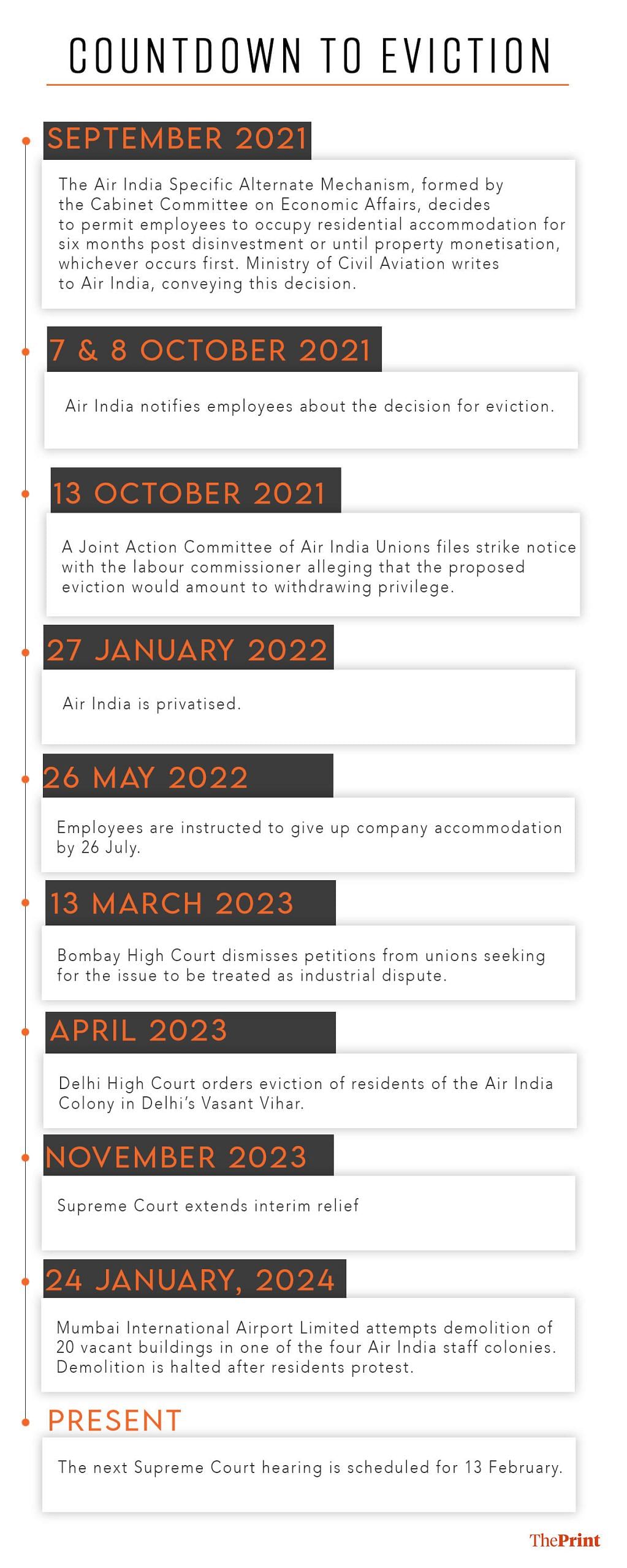
Once the ball was set in motion, residents were offered a temporary reprieve in 2021: occupy the properties for six months after disinvestment or until sale, whichever came first.
However, those who defied eviction notices were warned of consequences, Bombay High Court documents show. These included the withholding or deduction of performance-linked incentives, a penalty charge of Rs 15 lakh calculated based on standard occupancy rates plus double the market rent for the period of unauthorised occupancy, and even the possibility of recovering the penalty charges from employees’ arrears.
Flight or fight
When all her family’s belongings were packed up and it was finally time to say goodbye, Kalpana Shardul cried like a baby. She had spent some of the best years of her life in the Air India colony, having moved in when her son was in kindergarten and leaving 17 years later in 2021, after he had completed his graduation.
Shardul, along with many others, made the difficult decision to leave the colony soon after the Ministry of Civil Aviation notified Air India on 29 September 2021 about the need to vacate the properties. Air India conveyed this decision to its employees on 7 and 8 October, documents filed with the Bombay High Court show.
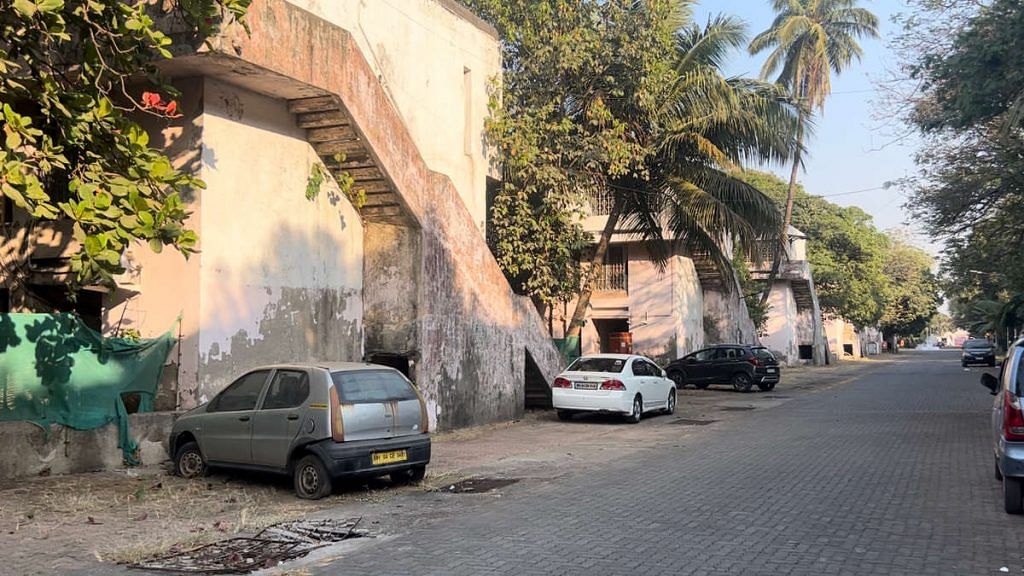
Despite their unhappiness, Shardul’s family, like many others who had alternative housing in Mumbai or could afford to rent or buy one, opted to leave rather than endure a prolonged legal battle. “We didn’t want the headache,” Shardul said. “We had an alternative—my mother-in-law’s small house in Sion. So, we left. Some others weren’t as fortunate to have a fallback option in Mumbai.”
Shardul’s husband, an assistant manager in materials management in Air India, was due to retire in 2023, so they were not entirely unprepared. For her, the taint was that instead of leaving proudly after retirement, they had to exit on a despondent note with a sense of panic all around them.
But for several others, eviction meant uprooting their lives and financial distress, so they decided to stay put instead of joining the exodus.
If such a small number of employees continue to hold on to the accommodations, the AIAHL will not be able to monetise the land to reduce the burden of debt of AIL put on it.
– Bombay High Court ruling
Then, on 27 January, 2022, the Maharaja returned to its founder— the Tatas. On 26 May, employees were once again asked to give up company accommodation, with a deadline of 26 July.
“About three unions came together to represent the residents left behind,” MP Desai said. “We first went to the labour court, saying that as per the agreement we should be able to stay here till retirement since housing is a service condition. They (Air India) argued that housing is not a service condition. Then we went to the Bombay High Court.”
However, last year, the high court dismissed the petition of protesting unions seeking the stalemate to be treated as an industrial dispute.
“Monetisation of lands and properties of Air India Limited is one of the essential terms of disinvestment process,” the court ruled on 13 March 2023. “If such a small number of employees continue to hold on to the accommodations, the AIAHL will not be able to monetise the land to reduce the burden of debt of AIL put on it… Petitions are devoid of merit and deserve to be dismissed.”
Subsequently, the protesting unions appealed before the Supreme Court, which granted interim relief. The next hearing is scheduled for 13 February.
Also Read: Gujarat GIFT city has been holding its breath for greatness. It’s a lifeless ghost town now
One set of rules, different interpretations
Several residents of the colony said they felt betrayed after dedicating their lives to the service of Air India, sometimes at personal risk. They maintain that a promise has been broken.
Sunita Rane, whose husband works as a ground supervisor and is due to retire in two years, pointed to how Air India employees continued to work throughout the Covid-19 pandemic. “They helped in the transport of essentials, equipment. Many got Covid. My husband and I also fell ill. Many from our colony have gone to strife-stricken nations to bring back flights of stranded Indians. We have done so much,” Rane said. “Why should they deny us what they had promised? A roof on our heads till we retire.”
The heart of the conflict lies in the Housing Allotment Rules 2017, which both sides interpret differently.
In their Bombay High Court petition, the residents’ unions claimed that Rule 22 allows employees to stay in company accommodation until termination or retirement.
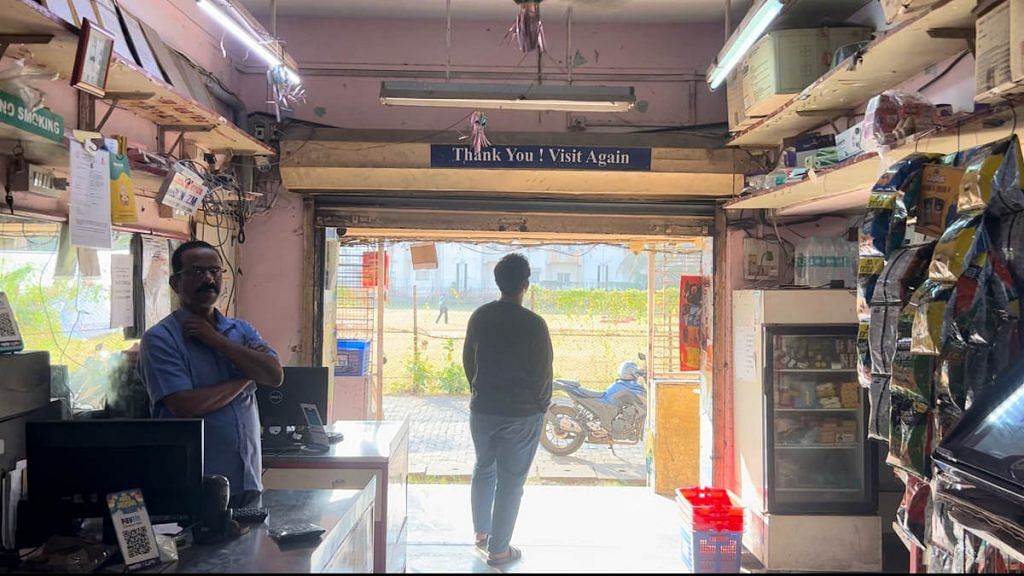
This rule, pertaining to leaving the staff quarters, states: “[T]he moment the allottee dies, retires, resigns or is discharged from the services, terminated for any reason whatsoever or abandons the service or is otherwise made ineligible for the allotment of a residence or commits breach of the terms and conditions of the rules herein contained, the allotment shall stand cancelled…”
However, in court, the respondents—including the Union ministries for labour & employment and civil aviation, as well as Air India Limited, Air India Engineering Services Limited, Air India Airport Services Limited, and AIAHL—cited other sections of the Housing Allotment Rules to refute the unions’ claims.
Additional Solicitor General of India Anil Singh, representing the Union ministries, argued that housing was never a term of employment given that the number of employees far exceeded available staff accommodation.
MIAL is committed to ensure the commensurate infrastructure at par with international standards is available in a time-bound manner, which depends entirely upon the availability of land
-Chhatrapati Shivaji Maharaj International Airport spokesperson
Singh pointed to Rule 1, which describes housing as a “welfare function” rather than a right. Further, he contended that Rule 5, which outlines the procedure for allotment, reinforces that housing is not a right. This rule details that eligible permanent employees are placed on three separate priority lists and offered apartments when their turn comes. If they decline or fail to respond within 15 days, their names are removed from the list.
Additionally, Singh cited Rule 20, which designates allottees as “licensees” under a leave and license agreement that grants temporary occupancy, but doesn’t give them any right or interest in the property.
While the government insists the leave and license agreement governs occupancy, the unions maintain it’s merely a formality and that their rights and entitlements are outlined in the Housing Allotment Rules.
All Air India employees who were granted housing signed leave and license agreements with the company. This standardised agreement, presented before the Bombay High Court, states: “I am merely a licensee at the company’s absolute will and pleasure in the said flat.” It further says that the company or the competent authority has the right to evict the resident and anyone staying with them “without assigning any reasons” at any time.
Another clause in the leave and license format specifies that if the licensee fails to vacate, the company will be entitled to remove them without being liable for trespass or damages. “I agree that in case I fail to remove myself and other persons staying with me and my and their belongings from the flat after being required to do so, I shall be guilty of trespass and wrongful restraint,” the document says.
Residents of the Air India colony in Delhi’s Vasant Vihar faced a similar legal battle. In April 2023, the Delhi High Court ordered their eviction, ruling that the residents were no longer government employees and, therefore, not entitled to government accommodation. Despite this defeat for their Delhi counterparts, the Mumbai Air India colony residents are pinning their hopes on the Supreme Court.
“Their (Delhi residents’) argument was flawed. They said, if the land anyway has to be monetised, it can be given to the residents at a standard rate. But, if they are affluent enough to buy this land, then they can definitely vacate the quarters and buy or rent their own homes,” Desai said.
24 January 2024
On 24 January, at about 2.30 in the afternoon, a convoy of police cars rolled in at one of the four Air India colonies in Kalina.There is tight security at the entrance, with the gates locked shut and a board warning that nobody will be given entry without permission, but the guards could not deny access to the authorities. Trailing the police cars was another convoy—comprising MIAL officials and demolition machinery.
For the distraught residents, it seemed like the beginning of the end.
“About a hundred police constables came, men and women. We were talking to the senior officials, saying we weren’t given any notice about all of this, when a bulldozer started smashing a first-floor balcony,” said a resident of the colony, asking not to be named since he is due to retire in a few months and fears reprisal.
News of the demolition spread like wildfire across the four colonies through WhatsApp messages. Within 10 minutes, a crowd of protestors formed, halting the demolition. But MIAL and police officials lingered until after 7 pm, leaving the residents on tenterhooks.
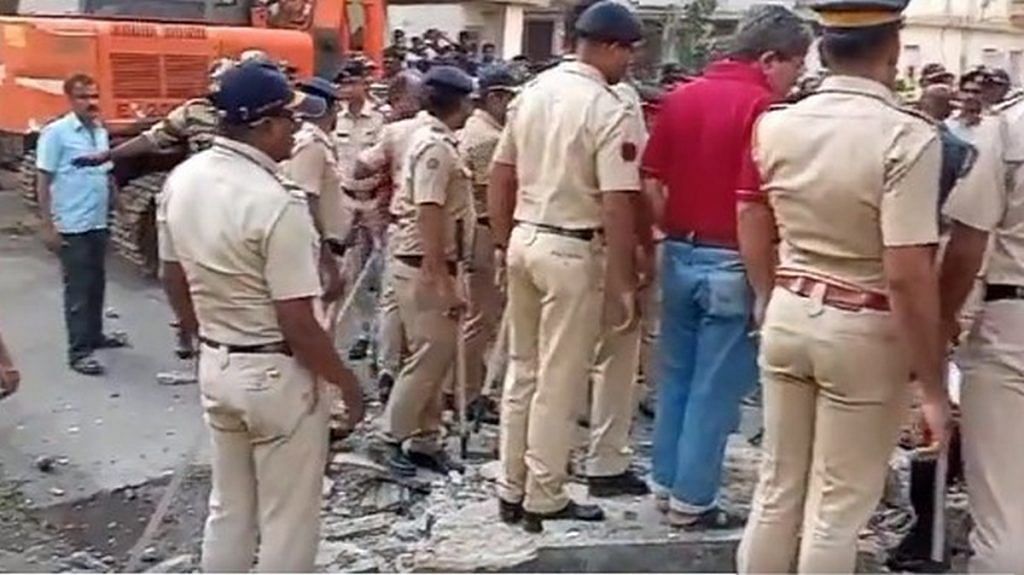
Residents say MIAL showed them a photocopy of the 7/12 extract (a land ownership document) and a photocopy of a letter from the AIAHL saying the land is being handed over to the airport authority.
A spokesperson of the Chhatrapati Shivaji Maharaj International Airport (CSMIA) told ThePrint that MIAL’s claim predates the privatisation, and that the entire airport land, including the area on which the housing colonies stand, was “demised” or transferred by AAI to MIAL through an “Operation, Management and Development Agreement” and a lease deed in April 2006.
The agreement between MIAL and AAI specifies that 53 acres were leased by the latter for staff housing colonies. However, according to Desai, While the four housing colonies occupy 53 acres, the entire land parcel, encompassing a sports ground, open spaces, and schools covers 184 acres.
In a statement on 25 January, MIAL said that the demolition was “in strict adherence to the law, in accordance with the permission/handover granted by AIAHL”. It further said that the company had initiated the demolition of only 20 uninhabited and dilapidated buildings to make way or the airport’s development, and that the remaining 80-plus buildings that are currently occupied will not be affected.
“Due process of law by filing eviction applications under the AAI Act (Airports Authority of India Act) are being followed for the same,” the statement said.
Elaborating on the reasons for the demolition attempt, the spokesperson said that the Mumbai airport, one of the busiest in the world, is “severely land constrained” especially in the face of “an enormous growth” in air and passenger traffic.
“In view of this, MIAL needs to use maximum land for development of Mumbai Airport. MIAL is committed to ensure the commensurate infrastructure at par with international standards is available in a time-bound manner, which depends entirely upon the availability of land,” the spokesperson added.
On Monday, 5 February, the Bombay High Court rejected the appeal of the Air India Staff Colony Association to restrain demolition.
Another tussle, another ‘heartbreak’
The buildings that MIAL wants to demolish may be vacant and dilapidated, but residents say the entire exercise seems like a blatant intimidation tactic to force them out.
“What about our drainage and water supply lines, our electricity cables? What if these get damaged during demolition? We can’t be expected to live on a demolition site,” said a visibly upset Rane, her arms akimbo. “The Supreme Court has given us interim relief. They should at least wait till the next hearing.”
The residents approached the Bombay High Court with these concerns, but MIAL has contested them. On Monday, 5 February, the Bombay High Court rejected the appeal of the Air India Staff Colony Association to restrain demolition.
This place was our heaven. All of this is now turning it into hell
-Air India Colony resident
The CSMIA spokesperson said that the residents’ claims are not valid, asserting that the Supreme Court’s court order places certain restrictions on Air India, but not MIAL.
“MIAL has initiated due process of law against employees of Air India who continue to remain in unauthorised occupation of flats in the housing colonies despite various orders passed by Bombay High Court. MIAL understands that the Supreme Court has restrained Air India (not MIAL) from recovering penal rent and damages. No relief or stay has been granted by any court with regard to the occupation of the structures,” the spokesperson said.
Reiterating that MIAL had strictly adhered to the due process of law, the spokesperson added that the Bombay HC had repeatedly ruled that employees could stay at the colonies only until 24 September 2022. “Against those who fail to vacate by 24 September 2022, appropriate proceedings available in law may be availed. MIAL has accordingly initiated eviction proceedings under the AAI Act against over 300 employees.”
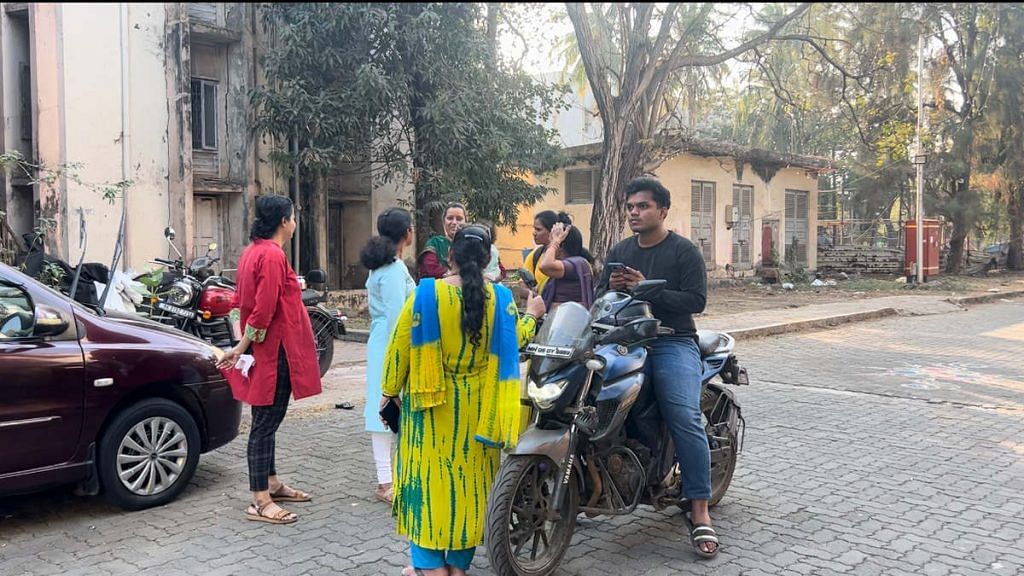
The afternoon after the demolition, Wagal and her friends stood in a huddle. For a few moments, the anxiety dissipated, replaced by a wave of nostalgia. They reminisced about bygone days—the monthly ladies’ club, the 56-dish chhappan bhog during the Ganpati festival, their children’s laughter echoing as they played cricket and forged lifelong friendships.
One of Wagal’s friends brought up a post on X by author and aviation consultant Sanjay Lazar, a former functionary of the Air India Cabin Crew Association. “Did you see what he wrote? It is absolutely on point,” she said.
Sharing a video of the demolition, Lazar had described the incident as a “moment of heartbreak” for those who’d grown up visiting the colonies. “An aviation chapter ends…” he wrote.
A gloomy pause followed the mention of the post. Then, one of the women in the group spoke: “This place was our heaven. All of this is now turning it into hell.”
(Edited by Asavari Singh)


